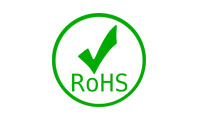The shore hardness of rubber: what is it and why is it important? These are questions we are frequently asked at AV Industrial Products.
In the engineering and design realm, shore hardness is an extremely useful metric. Broadly speaking, It helps to determine a material's ability to withstand deformation under an applied force.
A range of industries, including automotive, manufacturing and construction, all measure the hardness of rubber to understand product to application suitability.
In the following blog, we are tackling the shore hardness of rubber. We want to help you understand what it is, why it is important and how it influences the material selection process.
What is Shore Hardness?
Simply put, it is a test which measures a material’s resistance to indentation or penetration under pressure. It is primarily used for determining the hardness of elastomers, such as rubber and plastic materials.
First developed in the 1920s by Albert F. Shore, various scales have since been established to measure the hardness of different materials. Examples include Shore A, Shore D and Shore OO scales.
How Is It Measured?
A rubber hardness tester, called a durometer, is instrumental in recording the
the shore hardness of rubber. The device, consisting of a spring-loaded indenting needle, is pressed into the surface of the material and the depth of penetration is recorded. Simple, right?
A hardness value is then attributed to the material based on the depth of the indentation. The Shore A scale is commonly used for softer rubbers, whilst the Shore D scale is more suitable for harder materials like rigid plastics.
The values are expressed as numbers, with the higher numbers being reserved for harder materials. For example, a rubber material measuring 45A is softer and more flexible than that of a material measuring 70A.
Exploring Relevance in Different Applications
The hardness of rubber is a key factor that is considered during the material selection process in a range of applications. Some popular examples include:
-
Automotive Industry
Rubber components like tires, gaskets and seals play a vital role in ensuring the longevity and safety of vehicles. Using this scale allows engineers to accurately select the best material/ product for the application.
For instance, more flexible rubber is ideal for tyres whilst harder rubber ensures sufficient seal for an engine gasket.
-
Manufacturing
Rubber rollers, conveyor belts and shock absorbers: these are all rubber-based products that are vitally important in manufacturing.
The hardness of rubber used in these applications affects the performance and durability of the equipment, so it is important to get an accurate measurement.Thus, the shore hardness of rubber is a critical measurement which improves selection accuracy. Construction experts are better prepared to select reliable and suitable materials by using them.
In the medical industry, rubber is used in devices such as syringe plungers and seals. By having this easy-to-follow scale, those in this industry can make decisions that are likely to yield the correct results.
Selecting the right rubber material, with a suitable hardness rating, is essential for achieving the desired performance characteristics. In addition to the below, our comprehensive rubber selection guide may be of use. Here are a few examples of the scale.
Materials with this level of rating offer greater flexibility and more softness. They are often used in applications that require good sealing, vibration isolation and shock absorption. Soft rubber materials provide excellent grip and sealing properties but are not always the most rugged.
Rubber in this range offers a balance between flexibility and stiffness. Tyre manufacturing, industrial equipment and automotive components make use of rubber in this range. Durability and performance are guaranteed.
Materials with a higher shore value are used in applications where rigidity is required, such as in the creation of machinery components, rollers and industrial tools. Withstanding pressure and maintaining shape is the highest priority.
The D scale is used for measuring the hardest rubber materials. They offer exceptional durability and high resistance to deformation.
The hardness of rubber may seem like a trivial concern, but it is a hugely important metric in a number of industries and applications. Ultimately, it helps engineers and designers to make more accurate, informed decisions in the material selection process.
This is no joke. In many applications, choosing the incorrect type of rubber could present a significant safety compromise. As such, the existence of this scale helps to maintain safety and performance standards across sectors.
Understanding Shore Hardness allows us to harness the versatility and effectiveness of rubber materials in countless applications. If you are concerned about the suitability of a component in one of your projects, contact us. We are here to help as a rubber component expert.
Medical Devices
Selecting The Right Material
Soft Rubber (Shore A 30-40)
Medium Rubber (Shore A 60-70)
Hard Rubber (Shore A 70-90)
Very Hard Rubber (Shore D 40-85)




